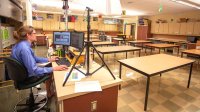Effective Instructional Models for a Hybrid Schedule
It can be a challenge to engage students when they’re at school only a few days a week—station rotations and flipping the classroom can help.
Your content has been saved!
Go to My Saved Content.How do you plan your class when students are allowed to come to school only a few times a week? That’s the question many teachers are facing as they confront the reality of a hybrid model where students attend school in person two or three days a week and spend the rest of their time learning online. It can be a challenge to engage all students in the same classroom activity when half are present virtually.
Blended learning represents an opportunity to personalize learning and reclaim instructional time in a hybrid schedule.
Flip the Classroom
Many teachers know the flipped classroom—where traditional lessons are delivered via video for students to watch at home while class time is reserved for students to collaborate and apply their learning. In a hybrid schedule, flipping the classroom is a great way to maintain instructional momentum. Students watch a lesson on remote days, then come in and apply their new knowledge in the classroom.
As in the classroom, short and direct mini-lessons can be most effective. Chunk longer content into shorter videos. Tools like Screencastify allow you to quickly record audio while talking over slides. Camera-shy teachers can remain present for their students by using the tool to help them find the important links and resources central to the daily work of the class.
Video is not the only tool for flipping the classroom. Try flipping with a text, image, or website for students to learn from at home. For example, the class might be asked to read and annotate an article about a current event and contribute to a group document where students share their thoughts. The next day, students meet in their groups and talk through and further develop the product they began virtually.
Encourage students to use a graphic organizer or something similar to collect and synthesize information. Gathering information in a central place can help students distill information and engage with it meaningfully. Asking students to assess and examine information, through an evaluative blog post for example, prior to live instruction time can improve engagement and help students think critically about the material.
Use in-person class time for students to work through an assignment first modeled online. Circulate in a socially distanced way, and talk with individual students about their work. After six months of remote work, many students are hungry for what English teacher Dave Stuart calls moments of genuine connection—small instances when teachers connect individually with a student. Students need to be respected, seen, and heard. Moving direct instruction online allows time for more connections in class.
Rotation Models
In a traditional blended learning format, students rotate through a series of stations within the classroom, including small group instruction and computer-based applications. In the hybrid schedule, spread these stations out over several days.
Catlin Tucker suggests that stations take several forms, including small group instruction, collaborative challenges, or other group work activities. After checking for understanding, create re-teaching stations for students struggling with a particular concept, while other students pursue enrichment or extension work. During face-to-face days, reserve some time to confer with students on their at-home work.
It might take some practice to envision what this could look like in the hybrid schedule. Consider reducing the total number of stations or splitting stations between online and in person. In school, students rotate through a teacher-led station and a group station; and at home, students work through individual materials at one station and videoconference with their peers in another.
Alternatively, use collaborative stations in class and save remote time for individual practice. Older students can use tools like Jamboard or Padlet to contribute to a collaborative product—either in the classroom or at home.
The Individual Rotation model provides personalization by allowing students to alternate between small group work at school and online learning at home. Students work through digital lessons to move along a skills progression tailored to their individual needs. For example, a teacher might assign a specific series of online math or literacy problems for a student to complete at home. While the learning sequence adheres to the class curriculum, students move through at their own pace and need. In class, students apply their learning through collaborative projects or other tasks. As with other strategies, reserve time to conference with individual students about their learning, hold them accountable, and discuss next steps. Many programs exist to support this work, including mastery-based learning modules on free sites such as Khan Academy.
Don’t be afraid to mix the methods. For example, station work in class could include a flipped video explaining a concept. Group rotations could be differentiated such that students completed different adaptive exercises based on their individual needs. Flexibility is key in experimenting with new strategies.
